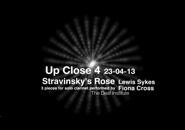Stravinsky Rose
Documentation and details of Stravinsky Rose and Exploding John Hyatt’s Pixels, performed and screened at UpClose 4, Deaf Institute, Manchester, UK, 23rd April 2013.
Relax and unwind with a drink and enjoy a blend of classical and contemporary music at close quarters. Arrive early for contemporary sound-based artworks by John Hyatt and Lewis Sykes, taking inspiration from the music at each event. Doors open at 7.30pm.
Tues 23 April 2013 – UpClose 4 – Deaf Institute
Gorecki – String Quartet no. 1 ‘Already it is Dusk’ – 15’
Stravinsky – 3 pieces for solo clarinet – 4.5’
Stravinsky – 3 pieces for string quartet – 8’
Brahms – Clarinet Quintet in B minor op. 115 – 40’
One of the foremost Polish composers of the twentieth century, Henryk Gorecki was thrust to sudden international fame on the release of a recording of his Third Symphony in the 1990s. His first quartet, written for the Kronos Quartet, is an intense, lyrical and darkly powerful work, showing more than a nod to the minimalist movement. Igor Stravinsky’s colourful and witty character comes to the fore in his 3 pieces for string quartet, and his 3 pieces for solo clarinet. Brahms’ Clarinet Quintet, a work of endless lyricism, is one of the composer’s undoubted masterpieces.
Stravinsky Rose
John Whitney Sr. is considered by many to be the godfather of modern motion graphics. Beginning in the 1960s, he created a series of remarkable films of abstract animation that used computers to create a harmony – not of colour, space, or musical intervals, but of motion. Based on the trigonometry of Euclidian geometry, Whitney used simple mathematical equations to form elementary animated figures which he argued could be viewed as a visual parallel to the sonic harmonic series. Inspired by Whitney’s legacy, Lewis Sykes and Ben Lycett have created a real-time visualisation to accompany Igor Stravinsky’s colourful and witty 3 pieces for solo clarinet, by adapting his geometric algorithm, ‘The Roses of Grandii’, to create dynamic, alternately diverging and converging, flower-like patterns, more or less equivalent to the harmonies within the music itself.
Exploding John Hyatt’s Pixels
This contemplative, silent, projected visualisation of a collection of John Hyatt’s paintings sets the tone for the UpClose music programme that follows. The piece is inspired by Daniel Shiffman’s ‘Explode’ demo from the creative coding platform Processing, which maps the pixels from a flat image into three dimensional space according to their brightness. Lewis Sykes and Ben Lycett have developed this into a hand-coded application that creates an abstracted ‘fly through’ of a virtual gallery – where the paintings are ‘exploded’ into a 3D field of multi-coloured pixels that slowly coalesce to reveal each image in turn. In contrast to the ‘gaze’ associated with experiencing paintings in the traditional gallery space it creates an alternative and evocative way to view John Hyatt’s work through a temporal and almost musical appreciation of colour, contrast and form.
Biogs
Lewis Sykes is a veteran bass player of the underground dub-dance scene of the 90s. He performed and recorded with Emperor Sly, Original Hi-Fi and Radical Dance Faction and was a partner in Zip Dog Records. He honed an interest in mixed media through an MA in Hypermedia Studies at the University of Westminster in 2000 and continued to fuse music, visuals and technology through a series of creative collaborations – most notably as musician and performer with the progressive audiovisual collective The Sancho Plan (2005-2008) and more recently as one half of Monomatic – exploring sound and interaction through physical works that investigate rich musical traditions. Director of Cybersonica – an annual celebration of music, sound art and technology (2002-2011), Sykes was also Coordinator of the independent digital arts agency Cybersalon (2002-2007), founding artists-in-residence at the Science Museum’s Dana Centre. He is in the third year of a Practice as Research PhD at MIRIAD, Manchester Met, exploring the aesthetics of sound and vibration.
Ben Lycett is a visual artist, filmmaker, technologist and programmer whose work investigates where art and science collide. His outputs range from interactive installations for museums and galleries to immersive sound reactive performances in night clubs nationwide. Ben is currently a lecturer on the BA Creative Multimedia, Manchester Metropolitan University and has recently been appointed as ‘Coder-in-Residence’ for {CODE Creatives} – part of Designing our Futures, the AHRC funded, skills development programme aimed at postgraduate and early career researchers in the North West.
And some documentation on Vimeo:
There’s also a ‘Planning for Stravinsky Rose‘ post of a collection of notes, research, reflection and links that show some of the thinking behind and development of the work at my Tumblr Digital Sketchbook.

